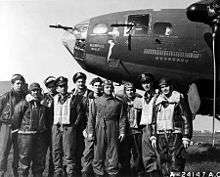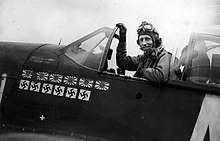Victory marking
A victory marking (also called a victory mark, kill marking, or kill mark) is a symbol applied in stencil or decal to the side of a military aircraft to denote an aerial victory achieved by the aircraft's pilot or crew. The use of victory markings originated during World War I, burgeoned during World War II and frequently took the form of the roundel or national flag of the nationality of the aircraft defeated.[1]


In the United States Air Force, as of 2010, victory markings are applied in the form of six inch green stars set within a black border with the type of aircraft defeated stenciled inside the star in white lettering.[2]
Several examples of victory markings being applied to aircraft for reasons other than aerial victories exist. During the period of its use for astronaut recovery, the U.S. Navy's Helicopter 66 bore victory marks showing a space capsule silhouette, with one mark added for each recovery in which it participated.[3] Meanwhile, in 2012, a Luftwaffe Eurofighter was spotted with a kill mark denoting a victory over a U.S. Air Force F-22 Raptor achieved in a simulated dogfight during a training exercise.[4]

See also
Further reading
- Apple, Carolyn (3 September 2015). "World War II Mission Symbols". Division of Historical and Cultural Affairs. State of Delaware. Retrieved 30 July 2019.
References
- Herman, Bruce (February 16, 2005). "Painted Warbirds". PBS. Retrieved May 11, 2018.
- "Air Combat Command 21-105" (PDF). af.mil. United States Air Force. Retrieved May 11, 2018.
- "Helicopter Unit Changes Command". Chula Vista Star-News. newspapers.com. September 26, 1971. p. 20. Retrieved February 7, 2018.(subscription required)
- Cenciotti, David (July 23, 2012). "F-22 Raptor kill markings shown off by German Eurofighter Typhoons". The Aviationist. Retrieved May 11, 2018.